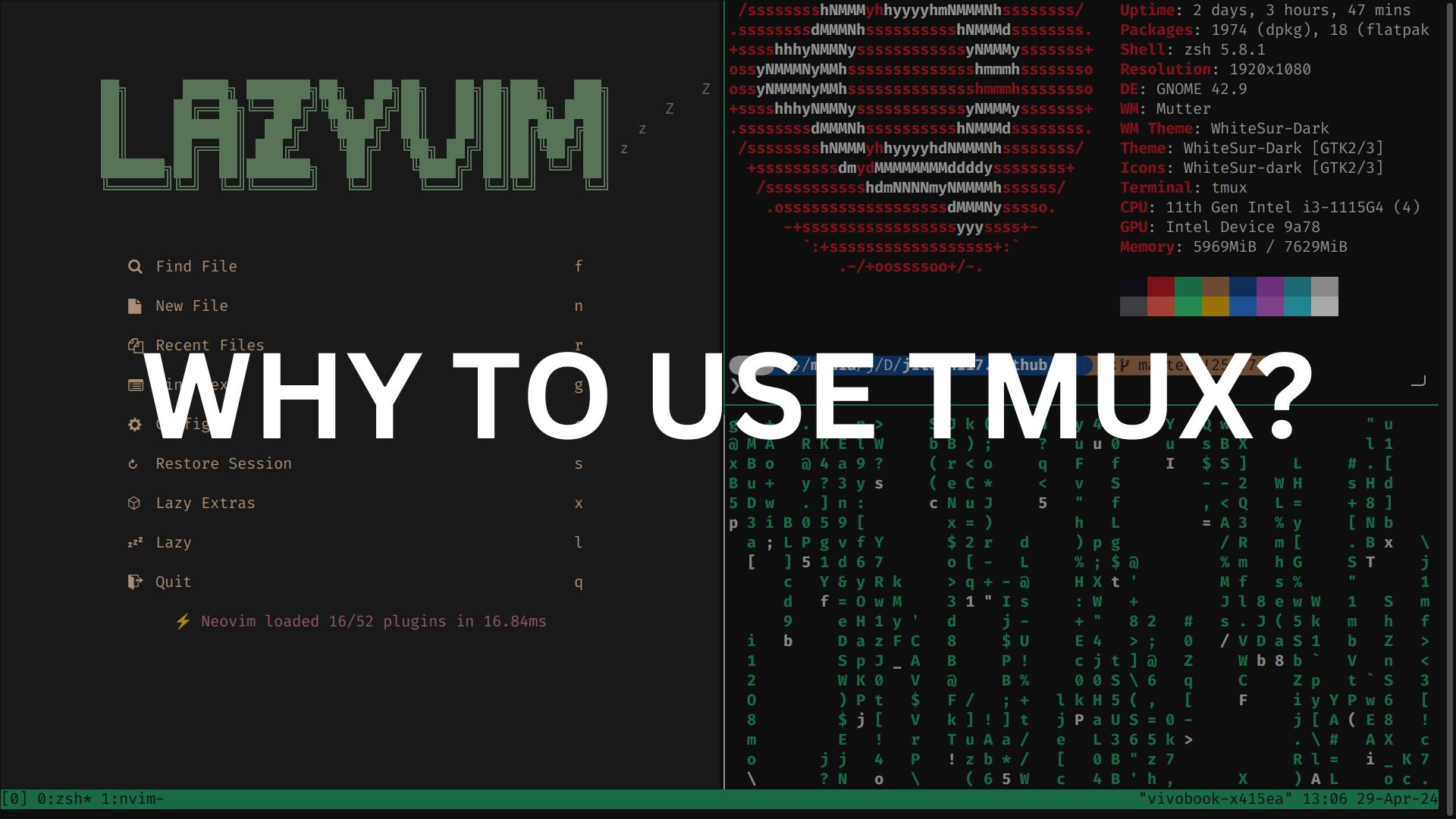1. Introduction
tmux (Terminal Multiplexer) is a powerful terminal utility that allows you to create multiple terminal sessions, split windows, and detach and reattach sessions with ease. It’s a game-changer for anyone who works heavily in the terminal, providing a robust environment for multitasking, remote server management, and efficient workflow.
Benefits of using tmux
- Persistent sessions: Detach and reattach sessions, ensuring your work is never lost
- Efficient window and pane management: Split your terminal into multiple windows and panes
- Enhanced productivity: Streamline your workflow by running multiple commands simultaneously
- Remote session sharing: Share sessions with other users for collaboration or pair programming
A Brief overview of its features
tmux offers a wide range of features, including window and pane management, customizable status bars, key bindings, plugins, and more. It’s highly configurable, allowing you to tailor it to your specific needs and preferences.
2. Getting Started with tmux
Installing tmux
tmux is available in most package managers for various Linux distributions and macOS. For example, on Ubuntu/Debian-based systems, you can install it with:
sudo apt-get install tmux
On macOS, you can install tmux using Homebrew:
brew install tmux
Basic tmux commands
To start a new tmux session, simply run tmux in your terminal. Once inside a session, you can use the following commands:
Ctrl+b d: Detach the current sessiontmux attach: Reattach a previously detached sessionCtrl+b %: Split the current pane horizontallyCtrl+b ": Split the current pane vertically
Navigating tmux windows and panes
Ctrl+b o: Switch between panesCtrl+b [space]: Switch between layout arrangementsCtrl+b [number]: Switch to the specified window
3. Window Management
Creating and closing windows
Ctrl+b c: Create a new windowCtrl+b &: Close the current window
Naming and renaming windows
Ctrl+b ,: Rename the current window
Switching between windows
Ctrl+b [number]: Switch to the specified windowCtrl+b n: Switch to the next windowCtrl+b p: Switch to the previous window
Splitting windows into panes
Ctrl+b %: Split the current pane horizontallyCtrl+b ": Split the current pane vertically
4. Pane Management
Creating and closing panes
Ctrl+b %: Split the current pane horizontallyCtrl+b ": Split the current pane verticallyCtrl+b x: Close the current pane
Navigating between panes
Ctrl+b o: Switch between panesCtrl+b [arrow key]: Move focus to the specified pane
Resizing panes
Ctrl+b [arrow key]: Resize the current pane in the specified direction
Arranging panes layout
Ctrl+b [space]: Cycle through different layout arrangements
5. Customizing tmux
Understanding the tmux configuration file
tmux is highly customizable through its configuration file, typically located at ~/.tmux.conf. This file allows you to set various options, key bindings, and styles.
Customizing the status bar
The status bar in tmux can display useful information such as the current session name, window list, system information, and more. You can customize its appearance and content by modifying the status-left, status-right, and status-style options in your configuration file.
Setting up key bindings
tmux allows you to define custom key bindings for various actions. For example, you can remap the default prefix key (Ctrl+b) or create shortcuts for frequently used commands.
Applying color schemes and styles
tmux supports customizing the color scheme and styles for different elements, such as the status bar, window names, pane borders, and more. You can define color schemes and styles in your configuration file using the set-option command.
6. Advanced tmux Features
Copying and pasting text
tmux provides a built-in copy and paste functionality. You can enter copy mode with Ctrl+b [, navigate and select text, and paste it with Ctrl+b ].
Scrolling and searching through history
tmux allows you to scroll through the terminal history using Ctrl+b [ and then navigating with the arrow keys or searching for specific text.
Setting up synchronize panes
Synchronize panes is a powerful feature that allows you to send commands to multiple panes simultaneously. This can be useful for running the same command across multiple servers or environments.
Using tmux plugins
tmux supports a rich ecosystem of plugins that extend its functionality. Popular plugins include tmux-resurrect (for persisting and restoring tmux environments), tmux-continuum (for automatically restoring sessions after a system restart), and tmux-yank (for enhanced copy and paste features).
7. Practical Use Cases
Using tmux for remote server management
tmux is invaluable for managing remote servers. You can create persistent sessions, detach and reattach as needed, and run multiple commands simultaneously across different windows and panes.
Enhancing development workflow with tmux
tmux can significantly boost productivity for developers. You can split your terminal into multiple panes for editing code, running tests, monitoring logs, and executing various commands simultaneously.
Running long-running processes with tmux
tmux is perfect for running long-running processes, such as database migrations, build processes, or data processing tasks. You can detach the session and let the process run in the background, freeing up your terminal for other tasks.
8. Additional Resources
Recommended tmux plugins and configurations
- tmux-resurrect: Persist and restore tmux environments
- tmux-continuum: Automatically restore tmux sessions after system restart
- tmux-yank: Enhanced copy and paste functionality
Online resources and documentation
- tmux.github.io: Official tmux website
- tmux.sourceforge.net: tmux documentation
- r/tmux: Reddit community for tmux users
Troubleshooting tips
- Check the tmux version:
tmux -V - Reload the tmux configuration:
tmux source-file ~/.tmux.conf - Enable tmux logging:
tmux set-option -g default-command "tmux attach -d"
9. Conclusion
tmux is a powerful terminal multiplexer that can significantly enhance your productivity and workflow. With its ability to create persistent sessions, split windows and panes, and customize almost every aspect of its behavior, tmux is a must-have tool for anyone who spends a significant amount of time in the terminal.
I encourage you to explore tmux, experiment with its features, and customize it to fit your specific needs. The initial learning curve may seem steep, but the benefits of mastering tmux are well worth the effort. Happy multiplexing!
